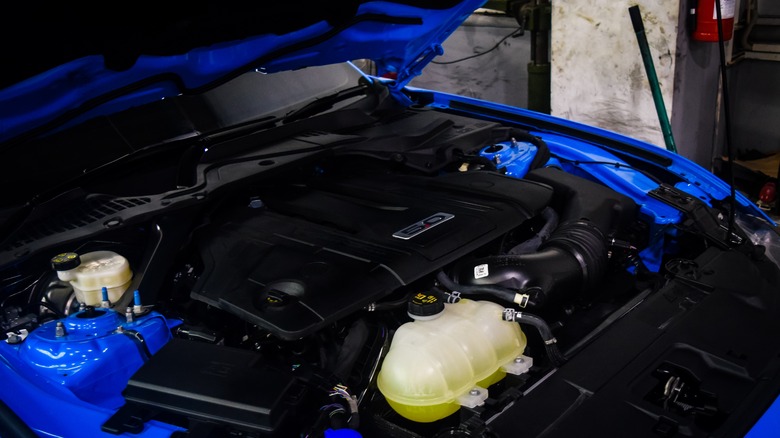What Makes Ford's Coyote One Of The Best V8's Ever Made
True car connoisseurs know that a vehicle's appeal is about so much more than just aesthetics. A stylish and sleek look is certainly a big plus, and a potential selling point in and of itself, but for an autophile, the components under the hood need to be taken into account too.
An admirer might take the time to recognize and appreciate something in particular like Ford's iconic V8 engine, the Coyote, which powers the automakers excellent sports cars just as much as its workhorses.
This particular five-liter engine, the muscle behind the company's F-150 and Mustang, is a unique and impressive model. It would go on to offer a blend of traits that can be difficult to achieve in the auto world: An increasingly environmentally-friendly performance and relatively modest size that still was capable of outputting considerable power. Here is why this engine continues to be so well regarded, and how it came to be.
The development of the Ford Coyote V8
Ford's 1991 Lincoln Town Car sported the country's first single-overhead V8. It was a huge leap for the company's V8 engines, which had seemingly been rather stagnant for some time prior — the company has had a curious history with V8s, after all. The goal at the time wasn't just to produce an enhanced engine, but to future-proof (as far as it's truly possible to future-proof anything) Ford's V8s and the vehicles that would be equipped with them. Engineer Jim Clarke led the charge, and the results would be transformative.
This 1991 model's V8 engine hit 3,200 rpm of torque and 190 horsepower. The concept would be further developed after the vehicle's introduction, leading to the larger-capacity Coyote. This five-liter engine was first fitted in the Ford Mustang GT, intended as a step towards further successes for Ford in the racing arena. The Mustang became an iconic racer for Ford, and the faith the company had in the car was plain to see. In fact, in an August 2023 interview, Ford's Jim Farley told Top Gear, "the original idea was never to have a new GT. We wanted to win Le Mans with the Mustang."
Expectations for the 2011 Ford Mustang GT were so high that the Coyote was developed for the model in particular. This new modular marvel was a cut above the Ford V8s that came before, for several different reasons.
The virtues and legacy of the Coyote engine
It would be easy to conclude that a more powerful engine will inevitably be more of a gas-guzzler, but this isn't necessarily the case. The Coyote V8's first incarnation offers a potent 412 horsepower and 4,250 rpm of torque, but remains a convenient and compact component: It weighs, in and of itself, just 430 pounds.
Into that (relatively) small package were crammed some sophisticated Ford features, including Twin independent Variable Cam Timing. This meant that the engine not only performs well, but does so efficiently and practically. Its lower-emission running was further bolstered by its compatibility with EcoBoost engine injectors.
Of course, there's no such thing as a perfect engine, but it's rare that one ticks so many of the boxes and strikes an effective balance of efficiency and performance as the Coyote did. The fact that different versions of it powered both a sports car and a pickup (camshaft configuration differences notwithstanding) is also a testament to its versatility.
It would benefit from upgrades and further tinkering over time — the 2018 Mustang's third generation Coyote had been bolstered to 460 horsepower. It's clear, then, that the engine had the staying power and potential it needed to make its mark on the history of Ford engines, just as the acclaimed Mustang itself did.


